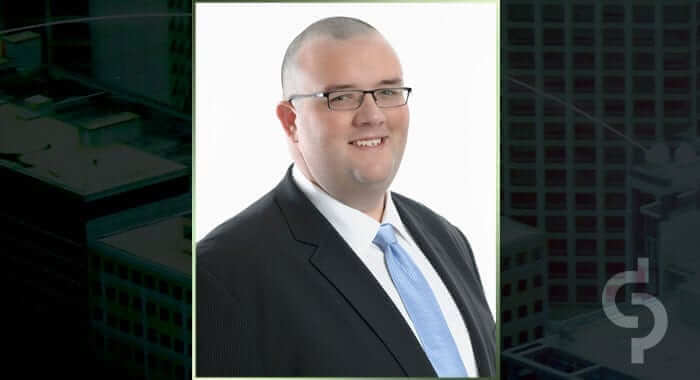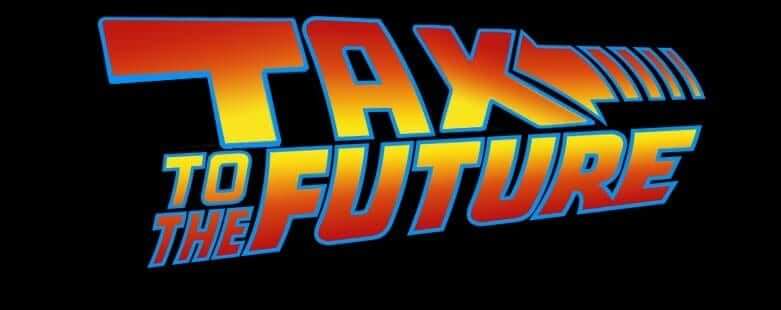Tax to the Future –
“If my calculations are correct, when this baby hits 88 mph, you’re going to see some serious s#!t”
With those words, Dr. Emmett Brown, more famously known as “Doc”, released the brake on his remote control for the DeLorean which sent the time machine straight at himself and Marty and started the cultural phenomenon known as Back to the Future.
Back to the Future was released in theaters on July 3, 1985 and became both an instant classic and the top grossing movie of the year. The film trilogy spawned 2 sequels that were released in 1989 and 1990, along with video games, theme park rides, a short-lived cartoon and a musical that will be released later in 2015. The Back to the Future film trilogy revolves around the adventures of Marty McFly and Dr. Emmett Brown as they travel through time and deal with the ripple effects of their actions. Interestingly, 2015 not only marks 30 years since the movie’s initial release, but it is also the year that Doc and Marty travel to in Back to the Future Part II.
The creators, Robert Zemeckis and Bob Gale correctly predicted several common technologies that we have today including video conferencing, drones, and tablets. However, they were incorrect about certain aspects of the future such as flying cars, hoverboards (one company is close though) and, thankfully, the continued use of fax machines. Despite all this, the film still provides an excellent starting point for discussing several tax concepts. As is the case with time travel, taxes are also a subject that most people are easily confused by. Between time paradoxes, passive activity losses, flux capacitors and foreign taxes, it is easy to understand why. By embracing the important lessons found in the movie, taxpayers may just be able to avoid a tax paradox that would otherwise unravel the space time tax continuum and destroy the entire universe!
Dr. E Brown, 24 hour Scientific Services: Personal & Business Taxes
Back to the Future begins with Doc requesting that Marty meet him at the Twin Pines Mall and bring the video camera to film his latest experiment. At the mall, Doc unveils the time-travelling DeLorean and sends his dog, Einstein, into the future, proving that his experiment is a success. He then explains to Marty the story of the time machine, from the fall off his toilet which gave him the vision of the flux capacitor, to how he financed the time machine using the Brown family fortune.
When Marty travels back to 1955 and finds Doc’s house, he sees a large sprawling estate and a luxury white automobile, along with the familiar lab, which is all that Doc still owns in 1985. Based on this, it is clear that Doc Brown had sold the large amounts of real estate and used the proceeds to fund his time machine. These transactions, like so many others, must have had a massive tax effect on Doc Brown.
Since this real estate and wealth came to Doc through his family fortunes, it means that the real estate will have a basis, or tax value, of whatever the fair market value was when he inherited the land from his family. When Doc sells this real estate to finance the time machine, his profit will be a capital gain, taxed at a preferential rate of 23.8% total, rather than a potential rate of 43.4%. Doc will also be able to exclude up to $250,000 of any gain since the land he sold was his primary residence, which is evident in 1955.
Once Doc sells the property, he has is able to take the cash proceeds and begin work on his time machine. As evidenced by the writing on the truck that the DeLorean emerges from in the opening scenes, Doc is in the business of science services, which makes the construction of his time machine part of his trade or business and allows him to take advantage of certain tax deductions and credits.
The initial infusion of capital into his scientific services business would be a taxable transaction, regardless of the structure of his enterprise. While many transactions between a business and its owner can result in taxes, the contribution of capital is not income for the business, nor a deduction for the person who contributed the capital. As Doc begins to spend this capital on parts and supplies needed for his time travel experimentation, he will be able to take deductions against income. He will also be eligible for the Research and Development tax credit which can be worth up to 14% of these qualifying expenditures. Throughout this 30 year process, it would be very helpful for Doc, from a tax perspective, to time these expenditures with his real estate sales so that he could potentially shelter that income from his taxes.
Once Doc completes his experiments on flux dispersion and the science of time travel, he would begin the construction of the time vehicle. Unlike the expenditures that were paid during the research and development phases of his venture, these construction expenditures would likely be capital in nature. Generally speaking, any expenses to build or construct an asset need to be capitalized and subsequently depreciated over the useful life of the asset. In Doc’s case, the purchase of the DMC-12 DeLorean would most definitely qualify as a capital asset and any improvements made to turn the DeLorean into the time machine would need to be capitalized as part of that asset. When the time machine is destroyed at the end of Back to the Future Part III, Doc would be able to deduct any remaining balance of the time machine asset that has yet to be depreciated.
Doc, in providing his scientific services, would likely see the value of asset protection and tax efficiencies in certain business structures. The best structures for his business would be a Limited Liability Company or an S Corporation. These structures would provide Doc with pass-through taxation, allowing him to take advantage of the above mentioned tax credits and tax deductions, and also permitting him to use the time machine personally without creating a taxable transaction. If Doc’s business were organized as a C Corporation, these credits and losses would be trapped on the corporate level and Doc’s personal use of the time machine could be considered compensation to him from the corporation.
Biff the Auditor
In Back to the Future Part II, Biff Tannen goes back in time from 2015 to 1955 in order to give his younger self a copy of Grays Sports Almanac, which contains the results of every sporting event through the year 2000. Armed with this knowledge, young Biff places lucrative wagers that result in him amassing a large fortune and changing the course of history. Not only does he become corrupt and powerful, but his actions also have unintended consequences including Richard Nixon serving as President for 4 terms. When Doc and Marty return to the new 1985 (1985A), nothing is how they remembered it; Doc is committed to a mental institution and Marty is Biff’s step-son!
A tax audit is very similar to Biff’s actions in Back to the Future Part II. During a tax audit, the examiner goes back in time to a prior year and attempts to change the past. Generally, for small to medium businesses, these audits are triggered when a return has an unusual or suspicious transaction, but it is also possible for them to be chosen at random. When selected for an audit, the auditor will ask for documentation related to the previously filed return and will try to change the return’s position to one that is more favorable to the tax authority, much like Biff did to his own monetary position when he gave himself the almanac in 1955.
A tax audit, like Biff’s actions, can have far reaching consequences that affect the immediate present and the taxpayer’s future. The disallowance of certain deductions, credits or losses can result not only in problems for the tax return in question, but also for future tax returns. For example, if a tax auditor disallows a loss from a pass-through entity due to basis limitations, this could mean that the taxpayer may not have basis for future losses or have suspended losses for future years. Many times, a taxpayer will take the position that a transaction is not taxable, such as a reorganization of business structures or forgiveness of debt income, and the taxing authority will challenge this position in an audit. An unfavorable outcome could result in past tax due, which could present significant cash flow challenges for the future.
When Doc and Marty discover how 1985A was created, they made it their immediate mission to stop the alternate reality from ever existing by fighting back against their “auditor”. A good audit defense includes proper documentation, solid references to the Internal Revenue Code and a team of experienced tax professionals to help direct and manage the tax audit. While burning your documentation the way Marty burned the almanac might not be the best strategy, making sure that any position taken has proper support can help a taxpayer avoid their own 1985A nightmare reality and make the audit as simple as hydrating a pizza.

Edward McWilliams, CPA
Partner
Ed is a Partner in the firm’s tax and business advisory practice focusing on providing services to middle market private companies across different industries as well as to early stage startups. Ed has over a decade of experience providing tax and business consulting services to these companies of different sizes and across different industries, bringing a broad and diverse knowledge base and strategic solutions to the many complex issues that businesses face.





